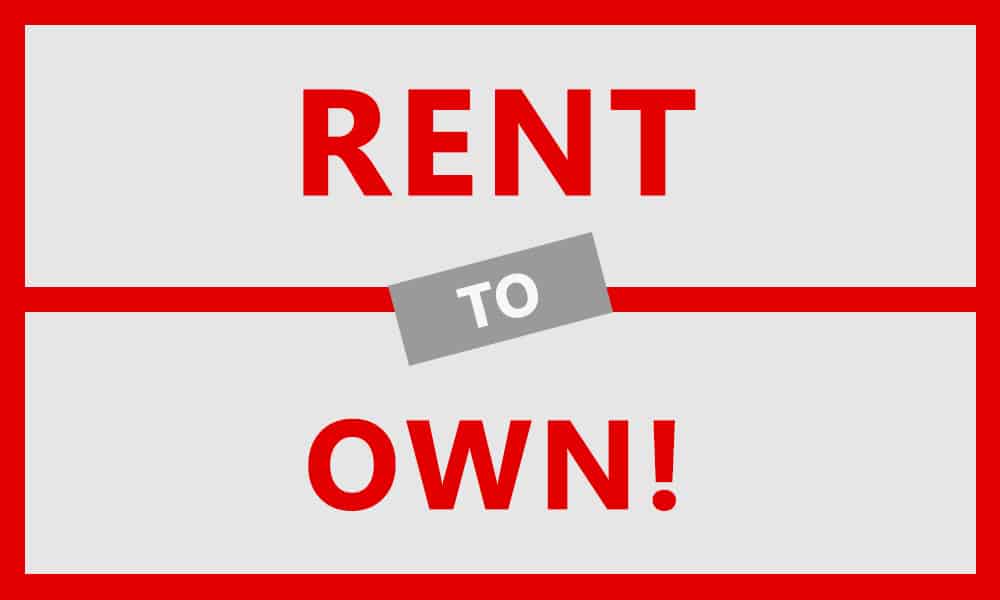

Many renters day dream of one day owning their own home, but may have trouble getting a mortgage or building up a down payment. In this situation, a rent-to-own agreement can help get you on the path to home ownership.
With a rent-to-own agreement, you get many of the benefits of renting a home while building towards the eventual purchase of the home you’re living in. This article will explain how rent-to-own works.
What is a Rent-to-Own Agreement?
Rent-to-own programs are designed to give renters a chance to build up a down payment on the home they are renting and to give homeowners a way to earn some extra money from renting their real estate.
A rent-to-own program starts with an agreement between the landlord and the renter. Before any agreement is made, the two sides must sit down and negotiate a few key parts of the rent-to-own agreement:
- The option fee
- The lease period
- The monthly rent
- The monthly rent premium
- The final sale price of the home.
The Option Fee
An option fee is a flat amount that is paid by the renter to the landlord when the agreement is signed. This fee secures the right for the renter to purchase the home at the end of the lease period.
If the renter does decide to purchase the home, the option fee becomes part of the down payment. If the renter decides not to purchase the home, the landlord keeps the fee anyway.
The Lease Period
The lease period is how long the renter will stay in the home. The renter will pay rent and a rent premium each month they stay in the home. Once the lease period expires, the renter will either need to purchase the home, renew the lease, or move out.
The Monthly Rent
The monthly rent is the amount that the renter must pay each month. This is no different that the rent on any lease.
The Monthly Rent Premium
The monthly rent premium is an additional payment that must be made each month. Like the option fee, this amount becomes part of the down payment should the renter decide to purchase the home. If the renter decides not to purchase the home, the landlord keeps the rent premiums.
The Final Sale Price
The final sale price of the home is agreed upon when the rent-to-own agreement is signed. Even if property values of nearby homes have risen or dropped, the sale price does not change.
Other things that you should ensure are specified in the contract are which party is responsible for maintenance and who pays the taxes or HOA fees.
I Own a Home. Why Should I Put it on the Market as Rent-to-Own?
If you own a home and want to earn some money from it, rent-to-own has a number of benefits.
The biggest is that you can generate more income from a rent-to-own home than by renting it normally. You’ll earn more than the market-rate because of the rent premium that the renter will pay each month. That can be the difference between real estate that generates a positive cash flow and real estate that loses money.
You’re also likely to have fewer problem renters with a rent-to-own agreement. If the renter is considering purchasing the home, they’ll want to help keep it in top condition.
Despite the uncertainty surrounding whether your renter will ultimately purchase the property, rent-to-own agreements can give you some certainty regarding the sale price of the home. If property values are falling, you’ll know the sale price of your home far in advance of the actual sale, so long as the renter decides to buy.
Of course, this can also work against you. If home values jump, your renter will be able to buy your house at a discount because the price is locked in at the beginning of the contract.
The other major downside of rent-to-own is that you must give your renter the right-of-first-refusal on the home. If someone else comes along and wants to buy the house, you cannot sell it to them. The rent-to-own agreement means that you have to wait until the lease ends and the renter decides not to purchase the home.
I’m Looking for Somewhere to Live. Why Should I Consider Renting-to-Own?
Rent-to-own real estate is a great way for people who have poor credit or trouble building a down payment to get on the path towards home ownership.
A rent-to-own lease can last a year or more. For buyers with poor credit or who need time to build their income, this time period can be exactly what they need to qualify for a mortgage. You can start to build equity through your option payment and rent premiums and continue building that equity once you’ve purchased the home.
You’ll also get to preview your future house in a way that most homebuyers don’t. If you find a major issue with the home, you’ll be able to back out of purchasing it, only losing the rent premiums and option fee.
The loss of rent premiums and option fees is the biggest downside for renters. If you are unable to qualify for a mortgage you can’t purchase the home for some other reason, you’ll lose the extra money you put into the agreement. If you’d signed a normal lease, you would have been able to keep that money instead.
Another issue is that you’ll still need to come up with the option fee to secure the rent-to-own agreement. While option fees aren’t as large as down payments, they can still be 3%-7% of the total value of the home.

